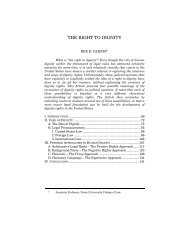A Right to Media? Lorie M. Graham - Columbia Law School
A Right to Media? Lorie M. Graham - Columbia Law School
A Right to Media? Lorie M. Graham - Columbia Law School
You also want an ePaper? Increase the reach of your titles
YUMPU automatically turns print PDFs into web optimized ePapers that Google loves.
490 COLUMBIA HUMAN RIGHTS LAW REVIEW [41:429<br />
their communities.” 236 The result of the BRACS project is that there<br />
are now over a hundred community radio and television broadcasting<br />
facilities known as Remote Indigenous Broadcasting Services<br />
(RIBS). 237 In addition, there are “25 licensed aboriginal community<br />
radio stations across the continent.” 238 While many stations receive<br />
substantial government funding, approximately two-thirds of<br />
aboriginal station funding comes from advertising sales. 239<br />
Australia has also worked <strong>to</strong> strengthen media access <strong>to</strong> its<br />
national television network, the Australian Broadcasting<br />
Corporation (ABC), which became a nationalized, state-owned<br />
corporation in 1932. 240 ABC has an Indigenous Program Unit (IPU),<br />
which was established in 1987 and concentrates on creating<br />
indigenous programming and improving the representation of<br />
Aboriginal peoples in the media. 241 IPU has produced several long<br />
running programs and funds media production within the Aboriginal<br />
and Torres Strait Islander communities. 242 An interesting component<br />
of the IPU is the Bonner Committee, which was launched on July 11,<br />
2003 and is designed <strong>to</strong> serve as a central point of conversation and<br />
dissemination of information on Aboriginal and Torres Strait<br />
236. Powerhouse Museum, Broadcasting for Remote Aboriginal<br />
Communities Scheme, http://www.powerhousemuseum.com/hsc/bracs (last visited<br />
Feb. 5, 2010).<br />
237. Kalinga Seneviratne, <strong>Media</strong>-Australia: Aboriginal Radio Holds Its<br />
Own, Inter Press Serv., Apr. 5, 2008, http://ipsnews.net/news.asp?idnews=41872<br />
(noting that “there are now 105 unique small community radio and television<br />
broadcasting facilities known as Remote Indigenous Broadcasting Services in farflung<br />
communities.”).<br />
238. Id.<br />
239. Id.<br />
240. Austl. Broad. Corp., All About the Australian Broadcasting System<br />
111 (2003), available at http://www.abc.net.au/corp/pubs/documents/ABC<br />
_Brochure_2003.pdf. ABC is entirely funded by the Australian government and<br />
has an annual budget of approximately $822 million dollars, which it uses <strong>to</strong> fund<br />
radio, television and online programming. Austl. Broad. Corp., ABC<br />
Budget 2006—2007 111 (2007), available at http://www.abc.net.au/corp/pubs<br />
/documents/budget2006-07.pdf.<br />
241. See Austl. Broad. Corp., About: Indigenous Program Unit,<br />
http://www.abc.net.au/indigenous/about/indigenous_program_unit.htm (last<br />
visited Feb. 5, 2010) (“The Indigenous Programs Unit (IPU) was established by<br />
the ABC in 1987, with the objective of becoming a centre of excellence for<br />
production of Aboriginal and Torres Strait Islander television in Australia.”).<br />
242. Id.















